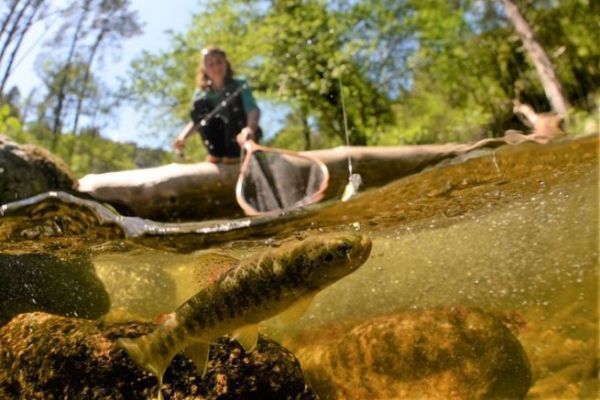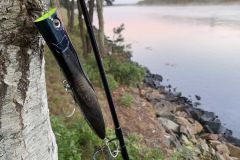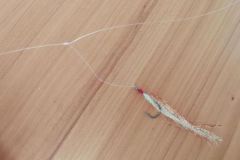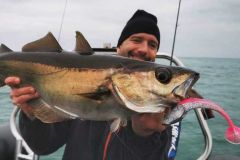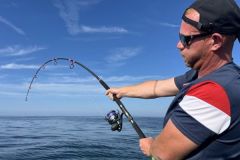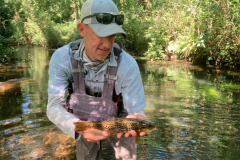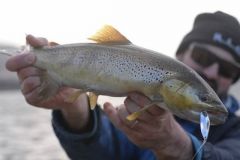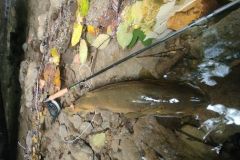Ultra-light principle
The ultra-light is a stream stalker for fario trout. This type of fishing is mostly practised in the mountains, although it can also be used in lowland streams. That's one of the reasons why it's a summer fishery in the mountains, after the snow has melted and when the flow is reduced. What's more, the water temperature allows you to fish with your feet in the water, without it being too uncomfortable.
It involves casting an ultra-light lure (less than 5 grams), often a spinning spoon or a small swimming fish, and prospecting the river. The aim is to beat ground upstream in search of active fish. Most anglers practice upstream fishing: that is, casting upstream and moving upstream. There are several reasons for this: fish, with their noses in the current, are less likely to locate us, and the relief of mountain streams often prevents "clean" downstream fishing (spots under waterfalls or certain boulders remain inaccessible).
It's a practice that combines precision and physical effort, but remains technically accessible.
Adapted equipment
To fish these rivers and the trout that live there effectively, you need the right equipment.
First of all, the rod must be short and light. Its length should be between 1m20 and 1m80, depending on the width of the watercourse. The use of a short rod is essential, as its reduced bulk means that you can cast correctly even in tight spaces caused by vegetation or the narrowness of a canyon. Throws are always short and precise. You can use a crossbow, balance beam, forehand or backhand shot, depending on the configuration of the desired position.
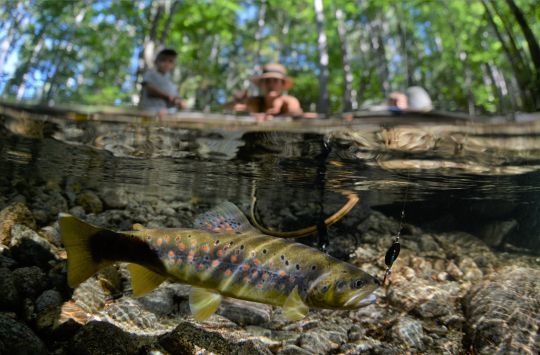
The power of the rod must be L or UL (Light or Ultra Light) to be able to cast lures weighing between 1 and 5 grams.
To equip this rod, you need a spinning reel (fixed spool) size 1000 or 2000, which combines lightness and low line capacity. No need for hundreds of meters, 75 m of nylon is more than enough. Most of the time, when fishing with ultra-light, you'll cast upstream. To maintain contact with the lure and retrieve it properly, you'll need a reel with a high retrieve ratio.
Nylon has several advantages. Its elasticity prevents unintentional unhooking, as it is better able to withstand the jumps and rapid movements of our trout. It resists abrasion better than braid in torrents where the line is subject to heavy friction. It offers discretion and softness on short casts. Colored nylon is very common. It allows you to follow the line with your eyes and see where your lure is moving, which is not easy with a translucent nylon with rough water in the background.
In addition to your ultra-light combo, you'll need to equip yourself for the river. A good pair of water-resistant walking shoes is an undeniable asset. Rather than a shoulder bag, you'll need a breastplate, which is lighter and gives you more freedom of movement. A pair of polarized glasses helps you spot posted trout by attenuating reflections on the water. Last but not least, a small landing net will ensure the catch that is quite common to land...
Lures for ultra-light fishing
We deliberately don't mention soft lures, which are an ultra-light practice in their own right.
The basis of the ultra-light is the use of a spinning spoon. This easy-to-use metal lure is very attractive, easy to cast and work at different depths and retrieve speeds. Silver and black are basic colors to own. Gold and copper regularly do well, especially in bright, sunny environments. Flashy, fluorescent colors are best reserved for waters pricked and troubled by storms or summer rainfall.
However, swimming fish are not to be neglected. There are days when trout respond best to the realistic silhouette of a swimming fish and to twitch and jerk animations. Small sinking swimmers are ideal for upstream fishing, as their inertia means they don't get swept up in fast water and are easy to animate. For downstream fishing, suspending or floating lures can be a useful trick for fishing under foliage or roots, simply by letting the lure drift under obstacles.

The more modern and less popular microspinner baits are also formidable. They combine the powerful vibrations of a spinning spoon with none of the disadvantages (thread twisting, among others). Equipped with a single hook, they also allow you to fish very close to the bottom, limiting snagging. This is particularly true in summer, when fine stringy algae can grow in the river bed and get caught in the prongs of treble hooks...
Finally, I've got into the habit of always taking wobbling spoons with me. On many occasions, they have enabled me to fish well when the trout are sulky and focused on hatching. They're also formidable on slow runs interspersed with a few twitches.
Lure rigging is the subject of much debate. Even if using a single barbless hook remains the most sporting way of catching trout, it has to be said that the number of unhooks is enormous. For my part, I use either single hooks or assit hooks (hooks tied by the shank to a loop of thick braid) with barb or barbless trebles. The Japanese, masters in this field, use barbed treble hooks to track natives.
Getting to know brook trout
The rivers we fish are generally small, rarely exceeding 10 meters in width. The water is cool and swift, and the riverbed is in relief. Brown trout are often small but combative, numerous and often sporting superb native liveries. They are fish adapted to their environment, which has evolved differently from one river to another since the last ice age. Every nook and cranny of the stream can shelter a fish, even in just a few centimetres of water.
However, there are a number of positions to be explored as a matter of priority: downstream of falls and the start of pools (deeper pools) are very productive, as fish can easily find food carried by the current and oxygen, while accelerating currents at the end of pools are often home to many fish, albeit of smaller size than in the previous position. In rapids, focus your lure passages near rocks and boulders that block the current and appear hollow downstream.
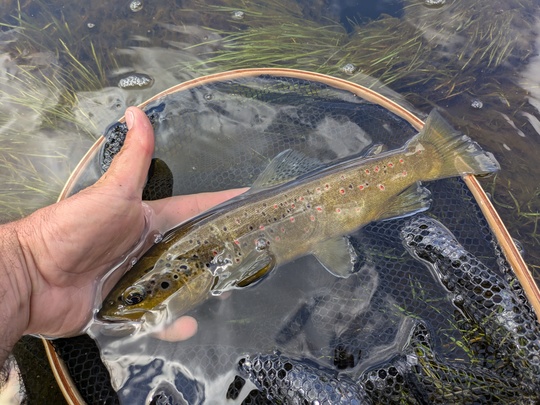
Hollow banks are often home to fish ready to pounce on your lure.
More generally, when prospecting and arriving at a new spot, always take a minute to observe, possibly spotting a fish, a gobage, or an interesting spot and the way you're going to move the lure over the spot. This will condition your cast and the way you hold your rod to make your lure move correctly on the spot and trigger a strike.
Bites are often hard and brutal. Your fast-sinking lure is intercepted by the fish, which attack it violently. Ideally, you should strike with the rod low to prevent the fish from jumping as soon as you strike, then reel in very quickly. Fish tend to swim downstream, resulting in a loss of tension in the line which favours hook release and stalls. On the best fish, a handy snowshoe landing net can be used to secure the fish and take a few photos, avoiding the fish coming into direct contact with dry ground or dead leaves.
Finally, on the subject of security, as some torrents can be relatively difficult to access, remember to alert at least one person to the location of your session.

 /
/ 